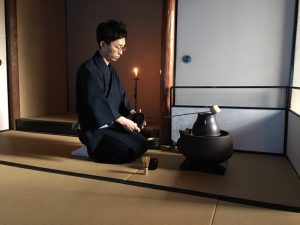A sense of peaceful melancholy came with the rain and gray skies, which blended in with Kyoto’s concrete skyline beautifully. Each droplet of rain against colored walls or windows felt like drops of sky falling toward the ground. I don’t know if this city has made me more poetic or sadly more pathetic — only my forthcoming thoughts will tell.
We spent the majority of today preparing for and partaking in a tea ceremony led by Dairiku Amae (Derek, in American speak), a 29-year-old tea master who lived around the world before settling in Japan. Our first encounter with him was at a dilapidated shrine that he compared to the one found in Akira Kurosawa’s Rashomon, a fitting reference considering the themes of past, present, and future that we are examining throughout this Winter Study course. The reason? Water, which we had to fetch from the fountain in the temple grounds (note: since it was raining today, Derek retrieved water the previous day to avoid contamination). While the 20-liter jug was filling up, he informed us of the central tenets of his tea practice: purity, labor, and intent, which manifested themselves within every step of the process.
After two bus rides and a stop to the sweetshop in between, we arrived at Derek’s home by Daitoku-ji. Upon entering, we were tasked with examining two sets of objects: the first consisted of things he found interesting, while tea-related apparatuses followed. I found it to be surprisingly familiar because of the work I’ve done in art history; dealing with paintings and sculptures within the museums and classes of which I’ve been a part is quite a similar task. Our focuses were on the weight and materiality of each object — my favorite part was handling either the radish root, which was lacy in nature, or the gingko berries, which was more fractal-like.

Unfortunately, my lunch was mediocre because I picked the wrong dish, a decision I still regret at the time of writing. However, the tea ceremony that followed redeemed this blemish on my day. We were led into the same room lit only by candlelight and prompted to sit along the room’s perimeter. From there, a rather formal ceremony took place, and it was interesting observing the movements and repetitions that amount to this ritual. At first, I thought it was overly formal, but during the question-and-answer period, Derek talked about the intimacy and vulnerability required to perform such an act. From that point, everything clicked — not only is the tea ceremony a means of self-reflection and -awareness, but it is also a means of connection between people.
Though I’m not a big fan of matcha, I want to implement the tea ceremony in some way within my life.

